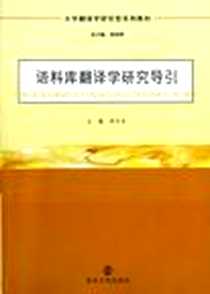《语料库翻译学研究导引》
《语料库翻译学研究导引》
出版时间:2012-12
出版社:南京大学出版社
作者:胡开宝
页数:390
字数:624000
《语料库翻译学研究导引》内容概要[E]
《大学翻译学研究型系列教材:语料库翻译学研究导引》共分九章,分别是“绪论”、“译学研究语料库的建设与应用”、“翻译语言特征研究”、“译者风格研究”、“翻译规范研究”、“翻译实践研究”、“翻译教学研究”、“口译研究”和“语料库翻译学研究:现状与未来”。每章由“导论”、“选文”和“研究实践”等三部分组成。
“导论”部分简要介绍语料库翻译学相关研究领域的历史演变和现状,梳理研究领域的研究内容、研究路径和代表性研究成果。
“选文”部分以语料库翻译学具体研究内容为依据,提供2-3篇代表性学术论文。这些文章绝大多数选自学术期刊,少量文章选自国际学术会议论文。编者在收录这些学术论文时,秉承尊重作者的原则,除少数文章因格式统一考虑作了适当调整之外,力求保持选文的原汁原味及其完整性。
《语料库翻译学研究导引》书籍目录[E]
第一章 绪论
导 论
选 文
选文一 Corpus Linguistics and Tralation Studies:Implicatio and
Applicatio
选文二 Corpus—based Tralation Research:Its Development and
Implicatio for
General,Literary and Bible Tralation
第二章 译学研究语料库的建设与应用
导 论
选 文
选文一 Corpora in Tralation Studies:An Overview and Some
Suggestio for Future Research。,。,
选文二 The ACTRES Parallel Corpus:An English-Spanish Tralation
Corpus
选文三 莎士比亚戏剧英汉平行语料库的创建与应用研究
第三章 翻译语言特征研究
导 论
选 文
选文一 Core Patter of Lexical Use in a Comparable Corpus of
English Narrative Prose
选文二 Spelling Out the Optionals in Tralation:A Corpus Study
选文三 A Parallel Corpus-based Study of Tralational Chinese
第四章译者风格研究
导 论
选 文
选文一 Towards a Methodology for Investigating the Style of a
Literary Tralator
选文二 Tralation Style and Ideology:A Corpus—assisted Analysis of
Two English Tralatio of Hongloumeng
选文三 Phraseology and Idiomaticity:A Progress Report on a
Corpus—based Study of Two Contemporary Chinese Veio of
Cervantes’Don Quixote
第五章 翻译规范研究
导 论
选 文
选文一 Collocatio in Popular Religious Literature:An Analysis in
Corpus—based Tralation Studies
选文二 Tralation Norms for English and Spanish:The Role of
Lexical Variables,Word Class and L2 Proficiency in Negotiating
Tralation Ambiguity
第六章 翻译实践研究
导 论
选 文
选文一 A Corpusbased Approach to Tee and Aspect in
English—Chinese Tralation
选文二 基于语料库的翻译语言分析——以SO…that的汉语对应结构为例
选文三 汉语“副职”英译的语料库调查研究
第七章 翻译教学研究
导 论
选 文
选文一 Towards a Methodology for a Corpus—based Approach to
Tralation Evaluation
选文二 Bilingual Comparable Corpora and the Training of Tralato
选文三 语料库与翻译教学
第八章 口译研究
导 论
选 文
选文一 Corpus—based Interpreting Studies as an Offshoot of
Corpus—based Tralation Studies
选文二 An Approach tO Corpus-based Interpreting
Studies:Developing EPIC(European Parliament Interpreting Corpus)
选文三 汉英会议口译语料库的创建与应用研究
第九章
语料库翻译学研究:现状与未来
导 论
选 文
选文一 Computerised Corpora and the Future of Tralation Studies
选文二 Corpus-based Tralation Studies:Where Does It Come
from?Where Is It Going?
参考文献
《语料库翻译学研究导引》章节摘录[E]
It is my contention that translation evaluation will benefit from the adoption of a corpus- based approach. Given that translation evaluation entails making judgements about appropriate language use, it should not rely on intuition, anecdotal evidence or small samples; rather, such studies require empirical analyses of larger bodies of authentic text, as found in the corpus-based approach. Nevertheless, the corpus-based approach can be seen as complementary to some elements of more traditional approaches; for example, information provided by subject field experts can be explored more fully in a corpus, intuition can be verified using a corpus, or terms found in dictionaries or parallel texts can be used as access points into a corpus.
Translation evaluation can take place in many different contexts, but this article focuses on the development of an approach to translation evaluation that can be applied in the context of translator training. In brief, it shows how corpora can be used to help translator trainers who are not subject field experts to identify the conceptual and linguistic information that they need in order to be able to evaluate student translations. As such, it outlines a number of guidelines for helping evaluators to compile and exploit suitable Evaluation Corpora.
However, it does not attempt to identify a comprehensive typology of translation errors, nor does it provide specific indications as to how translations should be graded (i.e., there are no discussions along the lines of "errors of type A should result in the deduction of X number of marks"). Although it is clearly the case that translator trainers will have to grade at least some of their students' translations, the scope of this article is to develop a more general methodology that translator trainers can adopt in order to equip themselves with the information they need in order to be able to make sound decisions with regard to the seriousness of the errors they encounter.
The article is divided into four main sections. Section 2 briefly outlines some of the challenges facing translator trainers who need to evaluate student translations in an academic context. Section 3 provides a brief introduction to corpora and corpus analysis tools. Section 4 describes the general design of an Evaluation Corpus. Section 5 provides an example of how an Evaluation Corpus can be constructed and used to help a translator trainer evaluate student translations of a short text on digital versatile discs (DVDs).
……